The humpback whale (Megaptera novaeangliae) is a species of baleen whale. One of the larger rorqual species, adults range in length from 12–16 metres (39–52 ft) and weigh approximately 36,000 kilograms (79,000 lb). The humpback has a distinctive body shape, with unusually long pectoral fins and a knobbly head. An acrobatic animal known for breaching and slapping the water with its tail and pectorals, it is popular with whale watchers off Australia, New Zealand, South America, Canada, and the United States.
Males produce a complex song lasting 10 to 20 minutes, which they repeat for hours at a time. Its purpose is not clear, though it may have a role in mating.
Found in oceans and seas around the world, humpback whales typically migrate up to 25,000 kilometres (16,000 mi) each year. Humpbacks feed only in summer, in polar waters, and migrate to tropical or subtropical waters to breed and give birth in the winter. During the winter, humpbacks fast and live off their fat reserves. The species’ diet consists mostly of krill and small fish. Humpbacks have a diverse repertoire of feeding methods, including the bubble net feeding technique.
Like other large whales, the humpback was and is a target for the whaling industry. Once hunted to the brink of extinction, its population fell by an estimated 90% before a moratorium was introduced in 1966. While stocks have since partially recovered, entanglement in fishing gear, collisions with ships, and noise pollution continue to impact the 80,000 humpbacks worldwide.
A humpback whale can easily be identified by its stocky body with an obvious hump and black dorsal coloring. The head and lower jaw are covered with knobs called tubercles, which are actually hair follicles, and are characteristic of the species. The fluked tail, which it lifts above the surface in some dive sequences, has wavy trailing edges.[8] The four global populations, all under study, are: North Pacific, Atlantic, and Southern Ocean humpbacks, which have distinct populations which complete a migratory round-trip each year, and the Indian Ocean population, which does not migrate, prevented by that ocean’s northern coastline.
The long black and white tail fin, which can be up to a third of body length, and the pectoral fins have unique patterns, which make individual whales identifiable.[9][10] Several hypotheses attempt to explain the humpback’s pectoral fins, which are proportionally the longest fins of any cetacean. The two most enduring mention the higher maneuverability afforded by long fins, and the usefulness of the increased surface area for temperature control when migrating between warm and cold climates. Humpbacks also have ‘rete mirabile‘, a heat exchanging system, which works similarly in humpbacks, sharks and other fish.[citation needed]
Humpbacks have 270 to 400 darkly coloured baleen plates on each side of their mouths.[11] The plates measure from a mere 18 inches (46 cm) in the front to approximately 3 feet (0.91 m) long in the back, behind the hinge. Ventral grooves run from the lower jaw to the umbilicus about halfway along the underside of the whale. These grooves are less numerous (usually 14–22) than in other rorquals but are fairly wide.[11]
The stubby dorsal fin is visible soon after the blow when the whale surfaces, but disappears by the time the flukes emerge. Humpbacks have a 3 metres (9.8 ft), heart-shaped to bushy blow, or exhalation of water through the blowholes. Because humpback whales breathe voluntarily, the whales possibly shut off only half of their brains when sleeping.[12] Early whalers also noted blows from humpback adults to be 10–20 feet (3.0–6.1 m) high.
Newborn calves are roughly the length of their mother’s head. At birth, calves measure 20 feet (6.1 m) at 2 short tons (1.8 t) The mother, by comparison, is about 50 feet (15 m). They nurse for approximately six months, then mix nursing and independent feeding for possibly six months more. Humpback milk is 50% fat and pink in color. Some calves have been observed alone after arrival in Alaskan waters.[citation needed]
Females reach sexual maturity at the age of five, achieving full adult size a little later. Males reach sexual maturity at approximately seven years of age. Humpback whale lifespans range from 45–100 years.[13] Fully grown, the males average 13–14 m (43–46 ft). Females are slightly larger at 15–16 m (49–52 ft); the largest recorded specimen was 19 metres (62 ft) long and had pectoral fins measuring 6 metres (20 ft) each.[14] Body mass typically is in the range of 25–30 metric tons (28–33 short tons), with large specimens weighing over 40 metric tons (44 short tons).[15] The female has a hemispherical lobe about 15 centimetres (5.9 in) in diameter in its genital region. This visually distinguishes males and females.[11] The male’s penis usually remains hidden in the genital slit.
Both male and female humpback whales vocalize, but only males produce the long, loud, complex “songs” for which the species is famous. Each song consists of several sounds in a low register, varying in amplitude andfrequency, and typically lasting from 10 to 20 minutes.[21] Humpbacks may sing continuously for more than 24 hours. Cetaceans have no vocal cords, so whales generate their songs by forcing air through their massive nasal cavities.
Whales within a large area sing the same song. All North Atlantic humpbacks sing the same song, and those of the North Pacific sing a different song. Each population’s song changes slowly over a period of years without repeating.[21]
Scientists are unsure of the purpose of whale songs. Only males sing, suggesting one purpose is to attract females. However, many of the whales observed to approach a singer are other males, often resulting in conflict. Singing may, therefore, be a challenge to other males.[22] Some scientists have hypothesized the song may serve an echolocative function.[23] During the feeding season, humpbacks make altogether different vocalizations for herding fish into their bubble nets.[24]
Humpback whales have also been found to make a range of other social sounds to communicate, such as “grunts”, “groans”, “thwops”, “snorts” and “barks”.[25]
(From Wikipedia, October 21st, 2012)




